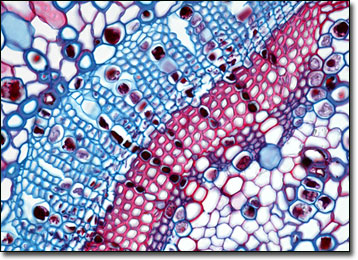Brightfield Microscopy Digital Image Gallery
Pine Needle
Pine trees are most heavily exploited for their wood, but these members of the genus Pinus are also utilized by humans in a number of other ways as well. Widespread and common in northern locales, pine tree seeds may be used to yield a variety of oils and their resin can be transformed into turpentine and rosin, among other commercially valuable commodities.

View an image of the pine needle section at 10x and 20x magnification.
Frequently referred to as evergreens, pine trees bear green needles through all seasons and all types of weather. These slender green leaves do not physically appear very similar to other sorts of foliage, but they are extremely efficient. Pine needles possess the ability to convert sunlight into food even during the chilly winter months, while minimizing the loss of water through evapotranspiration during the hottest months of the year because of their reduced surface area. The streamlined photosynthetic leaves are organized into sheathed bundles that are situated in a spiraling pattern along supporting shoots. The numbers of needles in each bundle is a species-specific characteristic, hard pines usually exhibiting five in a group and soft pines only two or three.
In addition to the better-known commodities generated from pine trees, a number of useful, but less profitable items can be made from the needles of the evergreens. Some Native Americans, for instance, utilized the narrow leaves to brew a type of tea that they utilized as a form of medical treatment. Certain tribes also gathered shed pine needles from the ground in order to use them to weave baskets, a practice that is still carried out today in some parts of the world. Pine needle are perhaps more popular, however, in modern times as a source of aromatic oil and as a mulch for landscaping and farming.
BACK TO THE BRIGHTFIELD MICROSCOPY IMAGE GALLERY
